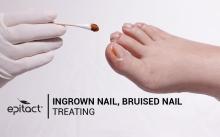
Black/Ingrown toenails
Toe protections to prevent or relieve ingrown and bruised toenails.

Free Shipping 
What is an ingrown toenail and a black toenail?
An ingrown toenail occurs when the edge of a toenail grows into the surrounding skin, causing inflammation and sometimes infection. It usually affects the big toe, either on one side or both. It is due to the compression of the skin fold against the lateral edge of the toenail.
A black toenail, also called subungual hematoma, corresponds to a bleeding under the toenail that causes its black discoloration.
Symptoms of ingrown and bruised toenails
The main symptom of an ingrown toenail is pain, which increases to touch and pressure on the toe. As the toenail penetrates more and more the fleshy folds, it leads to signs inflammation like swelling, redness and local warmth. If left untreated, the very sensitive skin fold becomes infected: it suffers sharp pain and pus is coming out of it.
Black toenail or bruised toenails also cause intense pain, especially aggravated by pressure from the shoe. It is well recognisable as the toenail turns black due to the accumulation of blood between the nail bed and the nail plate.
What causes an ingrown and black toenail?
The main cause of ingrown toenails is a bad cut of the nail. Indeed, cutting toenails too short or rounded or with pointed corners help the ingrowing of a toenail. But there are many other causes and risk factors like:
- tight or narrow shoes;
- heavy sweating;
- bone or joint deformity (hammer toe, bunion, arthritis);
- deformed toenails;
- regular sport practice;
- age (teenagers, young adults);
- familial predisposition.
Regarding black or bruised toenails, their main causes are a blow or crush to the end of the toe (distal phalanx), frictions or repeated traumas. This is why sportspersons, especially hikers and runners, more often have black toenails.
How to prevent ingrown toenails and black toenails?
To avoid ingrown and black toenails, fight against the risk factors following some tips:
- wear appropriate shoes with a wide toe box;
- have regular toenails care and clipping (in a square shape or slightly rounded);
- use silicone protections for toes during the first stage of your ingrown toenail or to relieve pain after treatment by a chiropodist. You can also wear them during risky activities (e.g.: sports practice) to avoid microtraumas and so bruised toenail;
- For ingrown toenails in particular, try to keep your feet dry and use products like castor oil or apricot milk.
Subungual hematoma, ingrown toenail: treatments
In the case of painful, infected or chronic ingrown toenails, see your GP or a foot specialist who will probably recommend you:
- antiseptic treatment (foot bath or local application);
- place some cotton between the toenail and the skin;
- antibiotics in case of infection;
- removal of the ingrown part of the toenail or the whole toenail;
- toenail splinting (gutter);
- silver nitrate stick to reduce the skin fold.
Black toenails usually disappear on their own but sometimes it is recommended to evacuate the blood by piercing the toenail. Ask your GP for advice.
The EPITACT® protections for toes against black toenails, bruising and ingrowing
To relieve a bruised or a black toenail or protect the nail after a surgery for ingrown toenail, EPITACT® has created daily* and sports toe protectors*. These silicone devices absorb micro-shocks and distribute pressure on the end of the toe. They create an ideal balance between thinness and effectiveness to provide comfort and relief no matter the shoes you are wearing. In the case of bruised toenails, they can avoid the development of the subungual hematoma and the toenail falling off.
*These solutions are class I medical devices that bear the CE marking under this regulation. Carefully read the instructions before use.
Manufacturer: Millet Innovation. 05/2023
To avoid the formation of an ingrown or a black toenail, cut it in a round shape.
FALSE! On the contrary, to limit the onset of an ingrown toenail, it is necessary to cut the toenail straight across, in a square shape and not too short. Those instructions are also useful to prevent black toenails!
There is only one type of ingrown toenail.
FALSE! Obviously, there is the ingrown toenail characterised by the penetration of the nail in the lateral skin folds. However, if the toenail is cut too short, it can become ingrown from its front end. In this case, it is called a distal ingrown toenail.
Only surgery can avoid recurrence of ingrown toenails.
TRUE and FALSE! Surgery is still the treatment recommended as a last resort. Several options are considered before. Orthonyxia is performed by podiatrists to definitely straighten the toenail. However, surgery doesn’t exclude the recurrence if the cause of ingrowing is not treated.
 Pharmacie
Pharmacie
